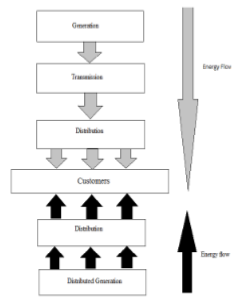Numerical Simulation of Optimized Placement of Distibuted Generators in Standard Radial Distribution System Using Improved Computations
Main Article Content
Abstract
The need for energy globally has increased recently. Additionally, the idea of distributed generation is propelled by the absence of suitable transmission capacity, exaggerated transmission and distribution disasters, and the release of power advertising. Numerous benefits of distributed generation (DG) include a decrease in energy loss during force transfer and a reduction in the length and width of electrical cables. By lowering power quality and other problems, the use of the DGs with the current force distribution arrangements may enhance the intensity standard. The impacts of distributed generators (DGs) are discussed in this article in relation to various operating situations and the voltage measurement output of the regulator, which is typically accessible in grid interface. The investigation's goals are to locate the best DG connection point in the DS, reduce the power and voltage profile, and improve compliance with the power efficiency limitations. The procedure has been simulated in the MATLAB Simulink system using the Institute of Electricity's test system (IEEE), and the results are displayed using numerical simulation. As a result, the system voltage profile was improved.
Article Details
References
G. Pepermans, J. Driesen, D. Haeseldonckx, R. Belmans, W.D’haeseleer, 2005. “Distributed Generation: Definition, Benefitsand Issuesâ€. Energy Policy, 33: 787–798.
W.El-Khattam, K.Bhattacharya, Y.Hegazy, M.M.A. Salama,“Optimal Investment Planning for Distributed Generation in aCompetitive Market,â€IEEE Transactions on Power Systems,Vol.19, No. 3, August 2004, pp 1674-1684.
G. P. Harrison, A. Piccolo, P. Siano, A. R. Wallace, “Exploring the Tradeoffs Between Incentives for Distributed Generation Developers and DNOs,â€IEEE Transactions on PowerSystems, Vol. 22, No.2, pp. 821 -828, May 2007.
Ramalingaiah Varikuti, Dr. M.Damodar Reddy, “Optimal Placement of DG Units Using Fuzzy and Real Coded Genetic
Algorithm,â€Journal of Theoretical and Applied Information Technology 2005 -2009, pp.145-151.
K.H. Kim, Y.J. Lee, S.B. Rhee, S.K. Lee, S.-K. You,Dispersed Generator Placement Using Fuzzy-GA in DistributionSystems. IEEE PES Summer Meeting, 2002, 3: 1148–1153.
Math H. J. Bollen, Mats Hager, “Impact of Increasing Penetration of Disturbed Generation on the Number of Voltage Dips Experienced by End-Customers,â€18th International Conference on Electricity Distribution, Turin, 6-9 June, 2005.
M. Chis, M. M. A. Salama, S. Jayaram, “Capacitor Placementin Distribution Systems Using Heuristic Search Strategies,â€IEEEProceedings, Generation Transmission Distribution vol.144, no.3,May- 1997.
L. Breiman, J. H. Friedman, R. A. Olshen, and C. J. Stone, Classifica- tion and Regression Trees. New York: Chapman & Hall, 1984.
Yammani, C., Maheswarapu, S., & Matam, S. (2011). Enhancement of voltage profile and loss minimization in distribution systems using optimal placement and sizing of power system modeled DGs. J Electr Syst, 7(4), 448-457.
Candelo-Becerra, John Edwin, and Helman Enrique Hernández-Riaño. "Distributed generation placement in radial distribution networks using a bat-inspired algorithm." Dyna 82, no. 192 (2015): 60-67.
Kuroda, Ken, Hideki Magori, Ryuichi Yokoyama, Yuichi Matsufuji, and Tomiyasu Ichimura. "Optimal allocation of dispersed generations in distribution networks to realize low-carbonate power system." Power System Technology 36, no. 12 (2012): 1-10.
Seker, Ayse Aybike, and Mehmet Hakan Hocaoglu. "Artificial Bee Colony algorithm for optimal placement and sizing of distributed generation." In 2013 8th International Conference on Electrical and Electronics Engineering (ELECO), pp. 127-131. IEEE, 2013.
Taghikhani, M. A., and M. Alami. "Modified Shuffled Frog Leaping Algorithm Application in Distributed Generation Sizing to Improve Line Losses Reduction Index.", April, 2012.
Ha, Maruthi Prasanna, Likith Kumar, and T. Ananthapadmanabha. "A novel approach for optimal allocation of a distributed generator in a radial distribution feeder for loss minimization and tail end node voltage improvement during peak load." Int Trans Electr Comput Eng Syst 2, no. 2 (2014): 67-72.
Murthy, V. V. S. N., and Ashwani Kumar. "Comparison of optimal DG allocation methods in radial distribution systems based on sensitivity approaches." International Journal of Electrical Power & Energy Systems 53 (2013): 450-467.
Manafi, H., N. Ghadimi, M. Ojaroudi, and P. Farhadi. "Optimal placement of distributed generations in radial distribution systems using various PSO and DE algorithms." Elektronika ir Elektrotechnika 19, no. 10 (2013): 53-57.
El-Maleh, Aiman H., Ahmad T. Sheikh, and Sadiq M. Sait. "Binary particle swarm optimization (BPSO) based state assignment for area minimization of sequential circuits." Applied soft computing 13, no. 12 (2013): 4832-4840.
Elmitwally, A. "A new algorithm for allocating multiple distributed generation units based on load centroid concept." Alexandria Engineering Journal 52, no. 4 (2013): 655-663.
Nadhir, Ketfi, Djabali Chabane, and Bouktir Tarek. "Firefly algorithm based energy loss minimization approach for optimal sizing & placement of distributed generation." In 2013 5th International Conference on Modeling, Simulation and Applied Optimization (ICMSAO), pp. 1-5. IEEE, 2013.
Kanwar, Neeraj, Nikhil Gupta, K. R. Niazi, and Anil Swarnkar. "Improved meta-heuristic techniques for simultaneous capacitor and DG allocation in radial distribution networks." International Journal of Electrical Power & Energy Systems 73 (2015): 653-664..

